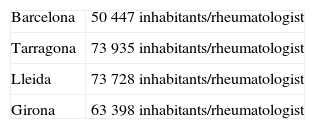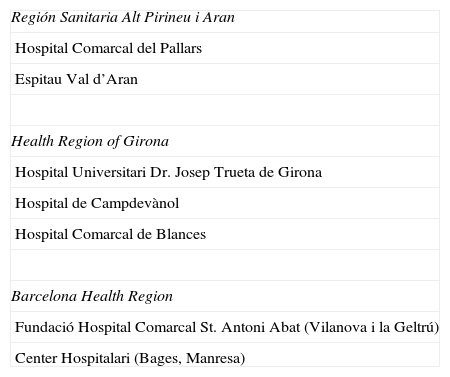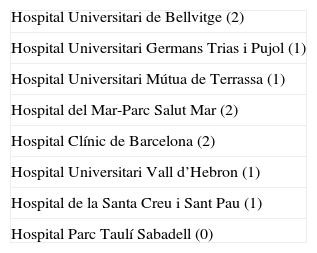To determine the current state of rheumatology in Catalonia (Spain) and to update information regarding previous studies.
MethodsStudy design: observational, descriptive and transversal. Sample: physicians practicing rheumatology in the public system of Catalonia. An epidemiological questionnaire was sent to all rheumatologists. The results were compared with previously published studies.
ResultsInformation was obtained on 130 rheumatologists (62 men/68 women, mean age 47±9 years). Seventy-five (57.7%) physicians worked at a hospital, 5 (3.8%) in primary care and 50 (38.5%) in both. Seven (11.9%) hospitals had no rheumatologist. Eight hospitals were accredited by the National Commission to develop a training program in Rheumatology. The number of residents accredited by each hospital was variable.
ConclusionsThe number of rheumatologists in the public health sector in Catalonia has increased 4.8% during the last seven years, unlike the 2005 study in which there was an increase of 40% over the previous eight years. There were 7 hospitals without a rheumatologist.
Determinar el estado actual de la reumatología en Cataluña, actualizando la información respecto los estudios previos.
MétodosSe trata de un estudio observacional, descriptivo y transversal. La muestra incluye a todos los médicos que ejercen actividad asistencial reumatológica en Cataluña. Se elaboró un cuestionario específico para el estudio y se remitió a todos los participantes. Los resultados se compararon con los resultados obtenidos en los estudios previos.
ResultadosSe obtuvo información acerca de 130 reumatólogos (62 varones/68 mujeres; edad media: 47 ± 9 años). La asistencia en reumatología se ejercía de la siguiente manera: 75 (57,7%) médicos trabajaban en el ámbito hospitalario, 5 (3,8%) en la atención primaria y 50 (38,5%) en ambos. En 7 (11,9%) hospitales no había reumatólogo. Ocho hospitales estaban acreditados por la Comisión Nacional de la Especialidad de Reumatología para la formación de reumatólogos mediante el programa MIR.
ConclusionesEl número de reumatólogos en el sector sanitario público de Cataluña solo ha aumentado un 4,8% en los últimos 7 años, a diferencia del estudio realizado en 2005, en el que se incrementó un 40% respecto a los 8 años previos. Actualmente, aún hay un hospital universitario sin reumatólogo.
Rheumatology is the medical specialty devoted to musculoskeletal diseases. It includes the study of connective tissue diseases, inflammatory arthritis, metabolic and bone disease and soft tissue rheumatism. The importance of musculoskeletal diseases is supported by a recent study that highlights the overall global burden of these problems,1 where musculoskeletal diseases are of the 3 leading causes of mortality and morbidity along with mental disorders and endocrine diseases. One-third of the general world population has some rheumatic diseases; therefore, it is important to determine the number of rheumatologists working in Catalonia and what their welfare and working conditions are today. So far, three studies have been performed in order to know the status of rheumatology care in Catalonia,2–4 both in hospitals and in primary care. The Catalan Society of Rheumatology (CSR) promotes this type of studies, to improve the quality of patient care with medical musculoskeletal diseases.
The objective of this study is to determine the current status of rheumatology in Catalonia and evaluate change from previous studies by the CSR itself.
MethodsThe study was an observational, descriptive, cross-sectional design with data collected from February 1, 2012 to April 30, 2012. The sample for the study was practicing rheumatologists with assistance care activity in Catalonia. Information was obtained by the listing of members of the CSR and the list of hospitals included in the Catalan Health Service (CHS). The CHS includes the Institut Català de la Salut and the centers run by the Xarxa d’Utilització Public Hospital.
We telephoned all hospitals requesting the number of rheumatologists and contact modality preference (preferably email). 143 rheumatologists’ emails were obtained. Subsequently all members of the CSR and emails obtained by telephone were contacted (via email) sending them a letter and questionnaire. Mail was forwarded on 3 occasions for those who did not reply.
We designed a questionnaire that included the following: center's name and address, number of rheumatologists at the center, accreditation for the training of specialists and number, availability of skilled nursing in rheumatology, recent retirements, recession of contracts during the period 2010–2012, rheumatologist name, date of birth, title of specialist in rheumatology, year and way of obtaining annual state-board certification of resident physicians (MIR) or other means-type of professional activity (hospital, private or primary), degree of dedication to public rheumatic activity (complete >30h/week, partial <30h/week) and professional contract type (fixed, temporary, part time or otherwise).
Information was collected on the number of people of different health regions of Catalonia by Pla de Salut de Catalunya (2011–2015) published by the Department for Health and IDESCAT (Statistical Yearbook of Catalonia). Today Catalonia is an autonomous community with an estimated population of almost 7 and a half million people.
ResultsInformation was collected on 138 physicians who practiced as rheumatologists in Catalonia. Six (4%) physicians exercised only in the private sector, one was registered as unemployed and one was devoted exclusively to research.
Thirty percent (94%) doctors (62 male/68 female with a mean age±standard deviation of 47±9 years) exercised their activity in the public sector. Fig. 1 shows the age distribution.
The process for obtaining the title of specialist in rheumatology was, in 114 (87.7%) cases, through the MIR and in 16 (12.3%) cases through other means.
Assistance care in rheumatology was exercised as follows: 75 (57.7%) doctors worked in hospitals, 5 (3.8%) in primary care and 50 (38.5%) in both. One hundred ten (84.6%) doctors worked full-time (more than 30h/week) and 20 (15.4%) worked partial shifts. Seventy-eight (60%) were also practicing rheumatologists in the private sector.
The type of employment contract was: 105 (80.8%) fixed, 9 (6.9%) interim, 2 (1.5%) eventual and 14 (10.8%) with other types of contract, including scholarships, replacements and service fees, among others.
Rheumatology nurses were available only in 17 centers (33%), 3 cases only part-time. 2 hospitals had a nursing assistant.
In the period 2010–2012 there have been seven retirements, 3 of which have been completely replaced, one is 50% covered and one case has lost 8h per week and in 2 cases there was depreciation of the post. In the same period there have been nine contract recessions, 8 of them in the health region of Barcelona and one in the health region of central Catalonia. Three rheumatology departments have been affected by layoffs in the last year.
Regarding the geographical distribution, 102 (78.4%) physicians practiced in the province of Barcelona, 11 (8.5%) in the province of Tarragona, 10 (7.7%) in the province of Girona and 5 (3.8%) in the province of Lleida. Two (1.6%) rheumatologists practiced in two provinces simultaneously. Table 1 shows the number of inhabitants per rheumatologist distributed by provinces.
The CHS includes 59 hospitals, 37 (62.7%) had full-time rheumatologists, but also partial in some cases, and 15 (25.4%) have only part-time rheumatologists. Seven (11.9%) hospitals did not have any rheumatologists. Table 2 shows hospitals that did not have a rheumatologist.
Hospital Centers That did not Have a Rheumatologist During the Period of February to April 2012 in the Public Sector in Catalonia.
| Región Sanitaria Alt Pirineu i Aran |
| Hospital Comarcal del Pallars |
| Espitau Val d’Aran |
| Health Region of Girona |
| Hospital Universitari Dr. Josep Trueta de Girona |
| Hospital de Campdevànol |
| Hospital Comarcal de Blances |
| Barcelona Health Region |
| Fundació Hospital Comarcal St. Antoni Abat (Vilanova i la Geltrú) |
| Center Hospitalari (Bages, Manresa) |
In terms of primary care, there are 3 primary care centers that had a rheumatologist (CAP Numancia Barcelona, Girona and CAP Güell, CAP Nova Lloreda in Badalona). The remaining sites had rheumatologists who worked mainly in hospitals and moved to primary care.
Eight hospitals were accredited by the National Committee of the Specialty of rheumatology for training rheumatologists using the MIR program. The number of accredited residents in each hospital is variable. One of the hospitals is currently accredited but has not yet formed any rheumatologists. Table 3 shows accredited centers for the training of specialists in rheumatology by the MIR program and the number of residents per year, at the time of study.
Centers Accredited for Specialist Training in Rheumatology via the MIR Program. Parenthetically we Detail the Number of Residents That Present Annually, at the Time of the Study (2012).
| Hospital Universitari de Bellvitge (2) |
| Hospital Universitari Germans Trias i Pujol (1) |
| Hospital Universitari Mútua de Terrassa (1) |
| Hospital del Mar-Parc Salut Mar (2) |
| Hospital Clínic de Barcelona (2) |
| Hospital Universitari Vall d’Hebron (1) |
| Hospital de la Santa Creu i Sant Pau (1) |
| Hospital Parc Taulí Sabadell (0) |
The present study describes the state of rheumatologists in their daily work in Catalonia during the period from February to April 2012.
We show that the number of rheumatologists currently practice in the public sector in Catalonia is 130, with an increase over the previous 2005 study of only six rheumatologists (5%). Note that the previous increase for the period between 1997 and 2005 was 40%, and during 1990–1997 the increase was 20%.
A very striking feature of this study is the existence of 7 hospitals that have not yet a single rheumatologist. If we analyze these data in relation to the results of previous studies, we found that the number of hospitals without a rheumatologist has reduced. In 1990, 18 hospitals did not have a rheumatologist, in 1997 the number decreased to 13 hospitals and in 2005, 10 hospitals were still without a rheumatologist. The present data allow us to state that, of the 7 hospitals that still do not have a rheumatologist, 3 are located in the province of Girona, which shows that there is not a homogeneous distribution of rheumatologists in Catalonia.
In 2012, the population of Catalonia was estimated at 7 and a half million, so we get a rate of approximately 1.7 rheumatologists per 100000. According to the latest “supply and demand for medical specialists in Spain 2010–2015” study,5 published by the Ministry of Health, Social Policy and Equality, Spain has a rate of 1.3 rheumatologists per 100000 inhabitants. Both rates are below the standards of quality of care in rheumatology6 which recommend one rheumatologist for every 40000–50000 inhabitants. The Aragonese Society of Rheumatology published in 2010 a description of the state of rheumatology in this autonomous community, which concluded that there is an insufficient supply of rheumatologists across the health sectors of the Aragonese Health Service, in all cases below the recommended quality standards.7
In a similar study by the Royal College of Physicians in 2009,8 a rheumatologist for every 86000 inhabitants is recommended. In this study, data of 531 rheumatologists and a rate of one rheumatologist per 114831 inhabitants were obtained, with a mean age value similar to our population (47 years) but with marked differences regarding gender, as seen in the British study of 70% men and 30% women. In our study, we observe that for the first time in Catalonia the number of women rheumatologists exceeds the number of men (62 male/68 female).
Regarding the age of rheumatologists, we saw an increase in the average age of rheumatologists; it is currently 47, and in the study conducted in 2005 it was 45 years. This increase can be attributed to many reasons and is also exacerbated by the lack of information that currently exists on the subject, due to the current economic situation, few have options to get a labor contract, and young rheumatologists (under 35 years) have had to emigrate to other countries or have repeated the MIR to access other specialties.
The increasing age of rheumatologists is a sobering fact and should be considered in future strategies. For reference, in the U.S., the value of the average age of members of the American College of Rheumatology is 56 years.9 A lack of rheumatologists based on the assessment of supply and demand in the coming decades is expected.10
The way of obtaining the title of specialist in rheumatology is currently through the MIR system in 100% of cases, with other possible routes seen in rheumatologists over 45 years of age. Assignment of rheumatology posts in 2012 was as follows: 54 rheumatology positions throughout Spain, including 10 in Catalonia and all in the province of Barcelona.
Assistance in rheumatology is mostly performed in hospitals, but the number of rheumatologists performing both inpatient and outpatient care has doubled, and the number of rheumatologists performing outpatient care only has decreased. The type of contract with which rheumatology care is carried out is distributed in 80% of fixed-term contracts, temporary in 7%, 2% and 11% any other. In relation to the results observed in previous studies, an increase in fixed-term contracts is seen.
Only 37% of hospitals has specialized nursing services. The quality standards of the Spanish Society of Rheumatology recommends that each unit should have a rheumatology clinic nurse and a nurse is recommended for every 3 medical consultations and one assistant per every 2 medical consultations.
These recommendations are very far from reality. In the study conducted by the Aragonese Society of Rheumatology there was no available nursing consultation in any of the health sectors. In the rheumatology unit of the Hospital San Juan de Alicante, a study was conducted to assess the activity of skilled nurses and concluded that it helped save on number of physician visits and that patients perceived greater control of their disease monitoring.11 Several European studies also support this fact and EULAR12–15 has made some recommendations to define the role of nurses in the monitoring of inflammatory diseases.
Another aspect that is striking is the differences in the growth of rheumatology services in different hospitals, some are twice the personnel seen in the previous 2005 study, while others remain stagnant. This is due, in most part, to the effects of the current economic crisis. Certain positions available due to retirements have been lost (2 in the case of rheumatology), there have been contracts cessations (in 9 cases and the majority in the province of Barcelona), there have been layoffs and today it is very difficult to produce new contracts.
The data collection was carried out during a limited 3-month period to avoid additional effects that might arise during the study. Yet the study has some limitations because basically there is no comprehensive census of rheumatologists with activity in the public sector in Catalonia. Although most rheumatologists are members of the CSR, this is not always the case and it has not been possible to contact all rheumatologists, especially with some younger replacement with different types of contract or grants. Another limitation stems from the methodology of analysis. In performing the calculations, both full-time and part-time rheumatologists have been counted as one unit. Rheumatologists working in different health regions were also counted as one unit in each region (e.g. 2 times) and those who work in more than one place within the same region were counted only once.
This study shows a stabilization effect of rheumatology in Catalonia. In some way, we are concerned at the low growth this past year, and the increasing age of rheumatologists. The assistance of rheumatology in Catalonia is not fair, and there are still public hospitals without a rheumatologist, including some in provincial capitals and Girona.
Ethical ResponsibilitiesProtection of people and animalsThe authors declare that no experiments have been performed on humans or animals.
Data confidentialityThe authors declare that they have followed the protocols of their workplace regarding the publication of data from patients and that all patients included in the study have received sufficient information and have given their written informed consent to participate in the study.
Right to privacy and informed consentThe authors state that no patient data appear in this article.
Conflict of InterestThe authors declare no conflicts of interest.
We thank all rheumatologists who participated in the performance of work, especially Dr. Vera Ortiz-Santamaria and Mayte Pizarro, secretary of the Rheumatology Department, Hospital Germans Trias i Pujol, for their help and support in the preparation of the manuscript.
The Catalan Society of Rheumatology wishes to thank UCB Pharma for granting financial support to carry out internal projects of the society, and in particular for the realization of this study.
Please cite this article as: Grados D, Marsal S, Olivé A. Asistencia reumatológica en el sector sanitario público de Cataluña: año 2012. Reumatol Clin. 2014;10:85–88.











